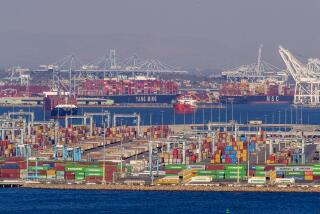Surge for oil in the wind?
- Share via
Hurricanes don’t have to blow very hard to raise energy costs, experts warned, and temporary hikes in the prices of gasoline and oil could occur soon.
But the markets said otherwise Monday.
Gasoline prices fell for the ninth consecutive week nationally -- for the 12th straight week in California -- and a barrel of crude gained only 11 cents as the dollar strengthened against foreign currencies.
Still, the experts said, tight gasoline supplies and another hurricane bearing down on the Gulf of Mexico are likely to cause prices to jump.
Gulf refineries and other petroleum facilities that were shut down as the previous storm, Gustav, approached were not yet back online, and Hurricane Ike could cause continued shutdowns even though its winds were weakening as it crossed Cuba on its way to the U.S.
“You might conclude that gasoline is headed down to $3 to $3.25 nationally from the way prices are dropping, but it’s going to be a mess in the gulf no matter what Ike does,” said Tom Kloza, chief analyst for the Oil Price Information Service.
“They can’t take the chance of operating these refineries and oil rigs in the middle of a storm,” Kloza said. “At the very least, we’re looking at more kinks in gasoline supplies and an updraft on prices in many states.”
Those factors loomed larger Monday than a potential reduction in oil production by OPEC.
Ministers of the Organization of Petroleum Exporting Countries, meeting this week in Vienna, were expected to decide today whether they would reduce output to stem a 28% slide in prices since oil’s record high of $147.27 a barrel on July 11. The closing price Monday was $106.34 on the New York Mercantile Exchange.
A formal announcement of a cut isn’t expected, but Saudi Arabia, which raised output earlier this year in response to sky-high prices, could “unofficially and quietly” rein in production, said James Ritterbusch, head of an oil trading advisory firm in Galena, Ill.
In the Gulf Coast, where 25% of the United States’ oil and 15% of its natural gas are produced, refineries also had to deal with widespread power outages and had to wait in line behind hospitals and other vital facilities when power was restored.
“For almost a week, we’ve had a large portion of refining activity down, and they have had some trouble getting back up,” Ritterbusch said.
As of Monday, four Gulf Coast refineries that accounted for an average of 600,000 barrels a day of production were still off line, said Doug MacIntyre, a senior oil market analyst with the Energy Department’s Energy Information Administration.
At the height of disruptions, 14 refineries were closed last week, idling 2.7 million barrels a day of refining capacity, MacIntyre said.
For now, motorists are still enjoying a little relief, though prices are 83 cents higher nationally and $1.02 higher in California than they were one year ago.
The price of a gallon of self-serve regular fell 3.2 cents nationally over the last week to $3.648, according to the Energy Department’s weekly survey of filling stations. In California, the price at the pump fell 4.6 cents to $3.859 a gallon.
California’s gasoline supplies are about as insulated from direct damage to gulf facilities as any state’s. But analysts also warned of indirect hits that the state’s motorists might take if a refinery in Canada and one in the Caribbean that usually ship to California decide in the coming weeks that it would be more profitable temporarily to send some of their gasoline to the gulf and South Atlantic states.
--
More to Read
Inside the business of entertainment
The Wide Shot brings you news, analysis and insights on everything from streaming wars to production — and what it all means for the future.
You may occasionally receive promotional content from the Los Angeles Times.











